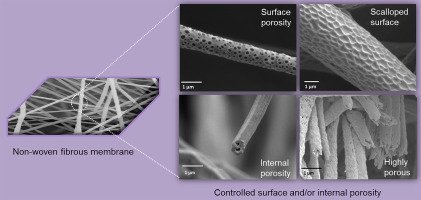当前位置:
X-MOL 学术
›
Eur. Polym. J.
›
论文详情
Our official English website, www.x-mol.net, welcomes your feedback! (Note: you will need to create a separate account there.)
Fabricating Porous Poly(lactic acid) Fibres via Electrospinning
European Polymer Journal ( IF 6 ) Pub Date : 2018-02-01 , DOI: 10.1016/j.eurpolymj.2017.12.025 C. Huang , N.L. Thomas
European Polymer Journal ( IF 6 ) Pub Date : 2018-02-01 , DOI: 10.1016/j.eurpolymj.2017.12.025 C. Huang , N.L. Thomas

|
Abstract In this paper, amorphous poly(lactic acid) (PLA), a biodegradable polymer with excellent bio-compatibility, is successfully electrospun into micron-sized fibres with controlled surface and internal morphologies. By careful solvent selection, either surface porosity or internal porosity can be achieved through different mechanisms. Use of chloroform as the solvent gives rise to circular pores of 100 nm diameter confined to the surface. These are obtained in humid conditions by the so-called ‘Breath Figure’ mechanism. It is found that combining chloroform with a water-miscible non-solvent yields either surface porosity (wrinkled effect) using a low boiling point liquid, e.g. ethanol, or internal porosity using a high boiling point liquid, e.g. dimethyl sulphoxide (DMSO). Both these microstructures are obtained through a non-solvent induced phase separation (NIPS) mechanism. Finally, it is found possible to produce both surface and internal porosity using DMSO by a vapour induced phase separation (VIPS) mechanism. The porous electrospun PLA mats were shown to exhibit significantly increased oil absorption capacity compared with the non-porous fibre mats.
中文翻译:

通过静电纺丝制造多孔聚(乳酸)纤维
摘要 在本文中,无定形聚乳酸 (PLA) 是一种具有优异生物相容性的可生物降解聚合物,成功地电纺成具有可控表面和内部形态的微米级纤维。通过仔细选择溶剂,可以通过不同的机制实现表面孔隙率或内部孔隙率。使用氯仿作为溶剂会产生直径为 100 nm 的圆形孔,限制在表面。这些是在潮湿条件下通过所谓的“呼吸图”机制获得的。发现将氯仿与可与水混溶的非溶剂组合使用低沸点液体(例如乙醇)或使用高沸点液体(例如二甲亚砜 (DMSO))产生表面孔隙率(皱纹效应)或内部孔隙率。这两种微结构都是通过非溶剂诱导相分离 (NIPS) 机制获得的。最后,发现可以通过气相诱导相分离 (VIPS) 机制使用 DMSO 产生表面和内部孔隙度。与无孔纤维垫相比,多孔电纺 PLA 垫显示出显着增加的吸油能力。
更新日期:2018-02-01
中文翻译:

通过静电纺丝制造多孔聚(乳酸)纤维
摘要 在本文中,无定形聚乳酸 (PLA) 是一种具有优异生物相容性的可生物降解聚合物,成功地电纺成具有可控表面和内部形态的微米级纤维。通过仔细选择溶剂,可以通过不同的机制实现表面孔隙率或内部孔隙率。使用氯仿作为溶剂会产生直径为 100 nm 的圆形孔,限制在表面。这些是在潮湿条件下通过所谓的“呼吸图”机制获得的。发现将氯仿与可与水混溶的非溶剂组合使用低沸点液体(例如乙醇)或使用高沸点液体(例如二甲亚砜 (DMSO))产生表面孔隙率(皱纹效应)或内部孔隙率。这两种微结构都是通过非溶剂诱导相分离 (NIPS) 机制获得的。最后,发现可以通过气相诱导相分离 (VIPS) 机制使用 DMSO 产生表面和内部孔隙度。与无孔纤维垫相比,多孔电纺 PLA 垫显示出显着增加的吸油能力。



























 京公网安备 11010802027423号
京公网安备 11010802027423号